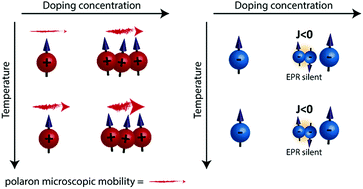Electron spin as fingerprint for charge generation and transport in doped organic semiconductors†
Abstract
We use the electron spin as a probe to gain insight into the mechanism of molecular doping in a p-doped zinc phthalocyanine host across a broad range of temperatures (80–280 K) and doping concentrations (0–5 wt% of F6-TCNNQ). Electron paramagnetic resonance (EPR) spectroscopy discloses the presence of two main paramagnetic species distinguished by two different g-tensors, which are assigned based on density functional theory calculations to the formation of a positive polaron on the host and a radical anion on the dopant. Close inspection of the EPR spectra shows that radical anions on the dopants couple in an antiferromagnetic manner at device-relevant doping concentrations, thereby suggesting the presence of dopant clustering, and that positive polarons on the molecular host move by polaron hopping with an activation energy of 5 meV. This activation energy is substantially smaller than that inferred from electrical conductivity measurements (∼233 meV), as the latter also includes a (major) contribution from charge-transfer state dissociation. It emerges from this study that probing the electron spin can provide rich information on the nature and dynamics of charge carriers generated upon doping molecular semiconductors, which could serve as a basis for the design of the next generation of dopant and host materials.

- This article is part of the themed collection: Special issue in honour of Seth Marder


 Please wait while we load your content...
Please wait while we load your content...